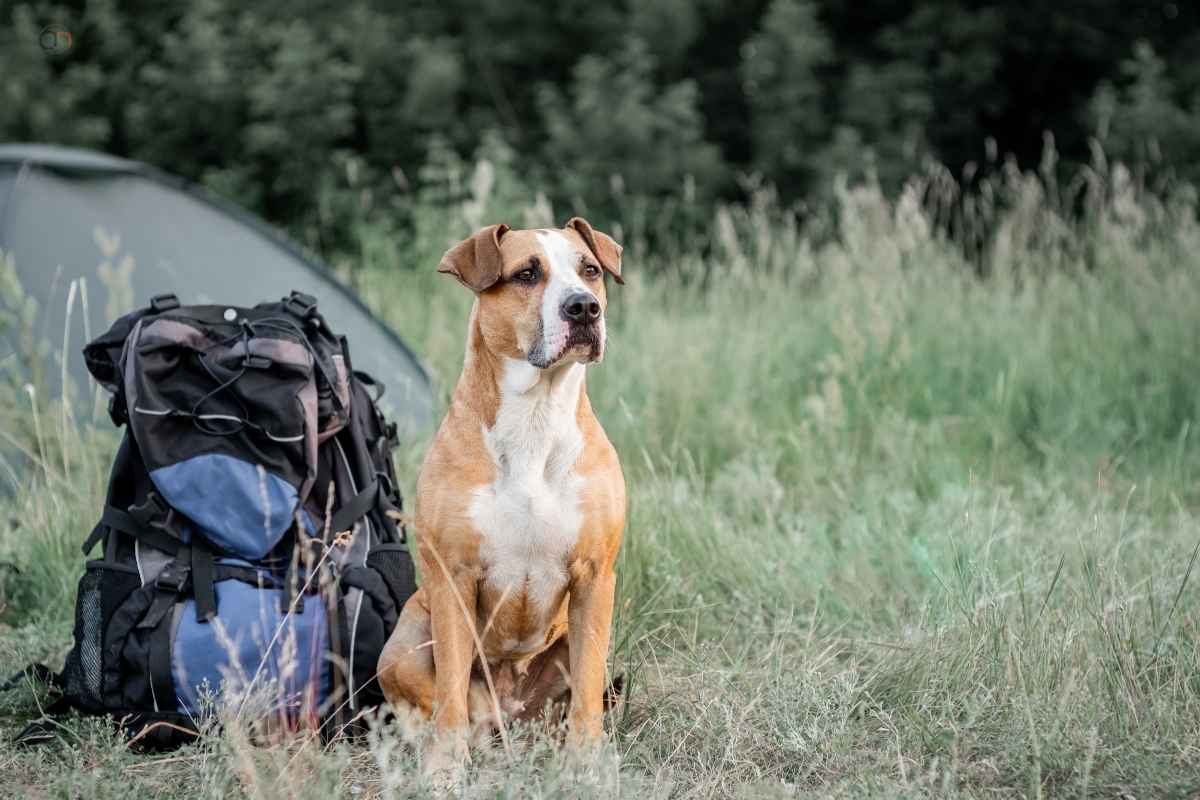There’s nothing quite like a road trip with your dog, whether you’re heading to a nearby park or exploring new places together.
But, traveling with a dog requires a bit of extra preparation to make sure the journey is enjoyable for both of you.
From keeping your dog safe and comfortable in the car to planning stops along the way, there are a few simple steps you can take to ensure a smooth ride.
In this blog, we’ll share how to take a road trip with a dog, stress-free and fun—so you can focus on making memories, not managing problems. Ready to hit the road with your furry companion? Let’s go!
Preparing Your Dog for the Trip:
TOC
Taking a road trip with your dog can be a fantastic experience, but a little preparation goes a long way in ensuring both of you have a comfortable and enjoyable journey. Here are five key tips to get your dog ready for the trip:
1. Schedule a Vet Visit
Before embarking on your trip, take your dog for a thorough check-up. Ensure they’re up-to-date on vaccinations, flea/tick prevention, and overall health. If your dog experiences travel anxiety or motion sickness, ask your vet for advice or medications that can help keep them calm and comfortable during the ride.
2. Take Short Test Rides
If your dog isn’t accustomed to long car rides, start with shorter trips to get them used to the car’s motion. Gradually increase the length of your drives to help them adjust to longer periods of travel. This will reduce stress and anxiety when the actual road trip begins.
3. Pack a Travel Kit for Your Dog
Prepare a travel bag filled with everything your dog needs for the journey. Include their food, water, medications, leash, waste bags, and any other essentials. Bring along their favorite toys, a blanket, or a bed to help them feel secure and comfortable while on the road.
4. Plan for Regular Bathroom Stops
It’s important to plan bathroom breaks throughout your trip. Dogs need to stretch and relieve themselves every couple of hours, so plan for stops at pet-friendly rest areas or parks. Research your route in advance to find the best places for dog-friendly stops.
5. Get Them Familiar with Their Travel Gear
Whether you’re using a harness, dog seat belt, or crate, make sure your dog is familiar with their travel gear before the trip. Let them wear the harness at home or take them on shorter trips in their crate so they feel comfortable and secure during the longer journey.
By preparing your dog in advance, you’ll set the stage for a fun and stress-free road trip. Safe travels!
What to Do if Your Dog Gets Sick or Stressed:
While road trips with your dog can be a blast, sometimes travel can cause stress or sickness. Whether it’s motion sickness, anxiety, or just the discomfort of being in a moving vehicle, it’s important to know how to manage these issues. Here are six tips to help you handle your dog’s sickness or stress on the road.
1. Identify the Signs of Motion Sickness
Motion sickness in dogs can happen just like in humans. Symptoms include drooling, vomiting, lethargy, or restlessness. If you notice any of these signs, pull over and give your dog a break. Keep the car cool, avoid sudden movements, and try driving smoothly. Also, refrain from feeding your dog a large meal before the trip to reduce the chances of nausea.
2. Take Regular Breaks
If your dog is feeling anxious or sick, taking breaks every 1-2 hours is essential. Allow your dog to stretch, hydrate, and use the bathroom. These stops not only help relieve physical discomfort but also reduce stress, making the trip more manageable for both you and your dog.
3. Use Calming Aids
If your dog is prone to travel anxiety or stress, try calming products to ease their nerves. Pheromone sprays, calming collars, or anxiety wraps are great options. Natural remedies like lavender essential oil or calming chews may also help relax your dog. Ask your vet for advice on which products may work best for your dog.
Read Next: How To Travel With A Small Dog
4. Make the Car Feel Like Home
Familiar items can help soothe your dog during the trip. Bring along their favorite blanket, toy, or bed to create a comfortable space in the car. Keep the temperature pleasant and play calming music to create a peaceful environment for your dog during the ride.
5. Stay Calm and Positive
Dogs can pick up on our emotions, so it’s important to stay calm if your dog is stressed. Offer lots of praise, treats, and gentle reassurance. Keeping a relaxed attitude will help your dog feel safer and more secure during the journey.
6. Consult a Veterinarian If Needed
If your dog’s sickness or anxiety is persistent or severe, it’s always a good idea to consult a vet. While some dogs may naturally outgrow motion sickness, others may require medication or behavior training to manage anxiety. A vet can provide solutions tailored to your dog’s specific needs.
Traveling with your dog can be a wonderful experience, but it’s important to be prepared for moments when sickness or stress arise. By following these tips, you can keep your dog comfortable and make the journey more enjoyable for both of you. Happy travels!
How to take a road trip with a dog:
Taking a road trip with your dog can be an exciting adventure, but it requires some planning to ensure the journey is as smooth and enjoyable as possible for both of you. Here’s everything you need to know about how to take a road trip with a dog.
1. Plan Your Route and Pit Stops
Planning ahead is essential when traveling with a dog. Here are a few things to consider:
- Find Dog-Friendly Stops: Research pet-friendly rest areas, parks, and hotels along your route. Some places even have designated dog-friendly areas or hiking trails where your dog can stretch and explore during breaks.
- Regular Bathroom Breaks: Plan to stop every 2-3 hours to give your dog a chance to relieve themselves and get some fresh air. This will prevent restlessness and help them stay comfortable.
- Locate Vets Along the Route: It’s always a good idea to know where the nearest veterinarians are, in case of an emergency.
2. Get Your Dog Ready for the Road
Making sure your dog is ready for the trip will reduce stress and make the journey more pleasant. Here’s how:
- Take Practice Rides: If your dog isn’t used to car trips, start with short drives to help them adjust. Gradually increase the length of the trips to build up their tolerance for longer journeys.
- Visit the Vet: Before you hit the road, check that your dog is up to date on vaccines and flea/tick prevention. If your dog suffers from motion sickness or anxiety, ask your vet about options for keeping them calm and comfortable.
- Pack the Essentials: Make sure to pack all of your dog’s essentials, including food, water, medications, waste bags, and a few familiar toys or blankets to help them feel secure.
3. Ensure Your Dog’s Comfort and Safety in the Car
Your dog’s safety and comfort should be your top priority while traveling. Here’s what you can do:
- Use a Harness or Seatbelt: Never let your dog roam freely in the car. A dog seat belt or a harness keeps them secure and prevents distractions while you drive. If your dog is small enough, consider using a carrier or crate for extra safety.
- Bring Comfort Items: Familiar items, like your dog’s bed, favorite blanket, or toys, will help them feel more relaxed during the ride. The more they feel at home, the less stressed they’ll be.
- Control the Temperature: Keep the car at a comfortable temperature to avoid overheating, especially if you’re traveling in hot weather. If it’s too warm, crack the windows slightly or use the air conditioning to keep your dog cool.
4. Keep Your Dog Entertained During the Drive
Long car rides can get boring for dogs, so keeping them entertained will help prevent restlessness:
- Chew Toys and Puzzle Games: Pack a few chew toys or interactive puzzle toys to keep your dog busy. These can help distract them and make the time pass more quickly.
- Frequent Stops: Take breaks every couple of hours to let your dog stretch, use the bathroom, and burn off some energy. These regular stops will keep your dog from feeling anxious or bored.
- Play Soothing Music: Some dogs find calming music or soft background noise helpful for relaxation. You can try playing gentle tunes to keep your dog calm and reduce stress.
5. Manage Travel Anxiety or Motion Sickness
If your dog is prone to motion sickness or anxiety during car trips, here are some tips for handling it:
- Motion Sickness Tips: If your dog gets carsick, avoid feeding them a big meal before the trip. Keep the car well-ventilated and drive smoothly, avoiding sharp turns or sudden stops. If needed, consult your vet about motion sickness medication or natural remedies.
- Calming Products: For anxious dogs, consider using calming sprays, collars, or anxiety wraps. Some dogs also benefit from natural remedies like lavender oil or calming treats. Ask your vet for the best options for your dog’s temperament.
- Stay Calm Yourself: Dogs can sense their owner’s emotions, so it’s important to stay calm and relaxed. Offer your dog reassurance with a soothing voice and positive reinforcement to help them feel secure.
6. Pack All the Essentials for Your Dog
To keep your dog comfortable and happy throughout the trip, here’s what to pack:
- Travel Gear: Make sure you have all the essentials, including food, water, leash, waste bags, and grooming supplies. Bring along a portable water bowl and travel-sized food containers to make feeding and hydrating on the go easier.
- Health Records: Carry your dog’s health records, especially if you’re traveling across state lines or internationally. These documents can come in handy if you need to visit a vet during your trip.
- First Aid Kit: A pet first aid kit is essential for any trip. Include items like bandages, antiseptic wipes, and any medications your dog may need in case of an emergency.
7. Be Prepared for Emergencies
While we hope everything goes smoothly, it’s always smart to be prepared for the unexpected:
- Know Emergency Vet Locations: Research emergency vets along your route, especially if you’re traveling through unfamiliar areas. Having this information on hand can save valuable time in case of an emergency.
- Consider Pet Travel Insurance: If you’re going on a longer trip or traveling internationally, pet travel insurance can offer peace of mind in case your dog needs medical attention during the journey.
A road trip with your dog can be a fun and memorable experience for both of you, but it’s important to prepare in advance. Follow these tips, and you’re all set for a smooth and enjoyable adventure with your best friend by your side!
Take Away
- A road trip with your dog can be a fantastic bonding experience, but it’s important to plan ahead to ensure the journey goes smoothly.
- From prepping your dog for the car ride to making sure they’re safe and comfortable along the way, careful preparation makes all the difference.
- With the right travel gear, frequent breaks, and a calm attitude, your road trip can be a memorable adventure for both you and your pup.
CTA:
- For more expert travel tips and pet-friendly road trip ideas, sign up for our newsletter.
- Be sure to also follow us on Pinterest for handy checklists and inspiration for your next adventure with your dog. Let’s hit the road!
FAQs | how to take a road trip with a dog
Q. should i take my dog on a road trip?
If your dog enjoys car rides and is comfortable with travel, a road trip can be a fun experience for both of you! However, it’s important to consider your dog’s temperament, health, and comfort level. Prepare by packing essentials, planning breaks, and checking if your dog is ready for the adventure.
Q. can i give my dog benadryl for a road trip?
Benadryl is sometimes used to help calm dogs with motion sickness or anxiety, but you should always consult your vet before giving it to your dog. The proper dosage depends on your dog’s size and health, so never administer medication without professional advice.
Q. How Do I Keep My Dog Safe in the Car?
For your dog’s safety, use a pet seat belt harness, crate, or carrier to prevent them from roaming freely during the trip. A secure dog is less likely to cause distractions and will feel more at ease in the car.
Q. How Often Should I Take Breaks for My Dog on a Road Trip?
It’s important to stop every 2-3 hours to give your dog a chance to stretch, hydrate, and relieve themselves. Frequent breaks will keep your dog comfortable and prevent restlessness or anxiety during long drives.
Q. What Should I Pack for My Dog on a Road Trip?
Be sure to pack the basics: food, water, bowls, waste bags, medications, a leash, and grooming supplies. Don’t forget your dog’s favorite blanket, toys, and any health records or vaccination documentation, especially if you’re traveling far.
Q. How Can I Help My Dog with Travel Anxiety?
To ease travel anxiety, try using calming products like anxiety wraps or pheromone sprays. Regular stops for bathroom breaks and relaxation, soothing music, and a familiar item like a toy or blanket can also help comfort your dog on the road.

Its Aliza R. Khan, a passionate travel blogger from Bangladesh. With a knack for inspecting hidden gems and sharing travel tips, I love to inspires readers to explore the world with curiosity and adventure.










